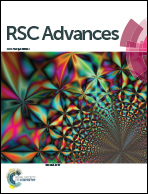Utilizing FBR to produce olefins from CO reduction using Fe–Mn nanoparticles on reduced graphene oxide catalysts and comparing the performance with SBR†
Abstract
Mn was used as a promoter for Fe nanoparticles (NPs) loaded on reduced graphene oxide (rGO). The prepared catalysts were the unpromoted Fe/rGO catalysts along with two Mn promoted catalysts FeMn16 and FeMn29. These catalysts were used as Fischer–Tropsch catalysts in a Fixed Bed Reactor (FBR). The operating conditions of the reactor, namely temperature, pressure and space velocity, were varied to evaluate the catalyst performance and the olefin productivity. The olefins were produced in maximum yields of 34.5% and 31.3% with FeMn29 at 320 and 340 °C respectively. The ratio of light to heavy olefins was three times higher at 340 °C. The catalysts showed good stability up to 50 h of interrupted operation while varying the conditions at each interruption. The performance of the catalysts in the FBR was compared with a previous investigation carried out in an SBR under identical conditions with the same catalysts. The FBR was found to be more Mn tolerant than the SBR, giving very high conversion activity with high Mn concentrations (FeMn29). The FBR produced olefins in much higher yields than the SBR. The SBR was more selective to light olefins at low temperatures and high Mn loading levels, while the FBR produced light olefins at higher selectivities at high temperatures and high Mn concentrations.



 Please wait while we load your content...
Please wait while we load your content...